#Sugarcane Bagasse Plate Making Machine
Text
In the need for sustainable and eco-friendly alternatives to single-use plastic tableware, bagasse plates have emerged as a promising solution. Bagasse, the fibrous residue left after extracting sugarcane juice, serves as the raw material for manufacturing biodegradable and compostable plates, bowls, and cups. This blog explores the process of making bagasse tableware and highlights the functions and features of various bagasse plate-making machines.
Raw Material For Sugarcane Bagasse Plate Making
Molded Fiber pulp sheets are used as the essential raw material for the production of disposable plates, and they are easily available in the market at highly affordable prices.
The transformation of waste sugarcane bagasse into clear and readily usable Molded Fiber (Disposable) pulp sheets entails undergoing a series of mechanical and chemical stock preparation processes, which closely resemble those employed in the paper manufacturing industry.
The cost of establishing a stock preparation system for Molded Fiber Pulp Sheets is twice as high as that of a Disposable Tableware production line. However, these bagasse pulp sheets are readily accessible in the market at a convenient price, which is why manufacturers of bagasse tableware prefer to utilize them.
Machinery and Systems Required for Disposable Tableware Manufacturing
The manufacturing process of disposable tableware, utilizing sugarcane bagasse as the raw material, requires the integration of numerous auxiliary systems and specialized machinery.
#Sugarcane Bagasse Plate Making Machine#Sugarcane Bagasse Plate#Bagasse Plate Making Machine#Bagasse Plate#Bagasse Plate Machine#Bagasse Plate Making#Molded Fiber pulp#Pulping system#Sugarcane Bagasse Tableware Formation Machine#Tableware Trimming Machine#Tableware Molds#pulp machine#paper mill#paper machine#parason#paper industry
0 notes
Text
Top 5 Materials Used in Packaging Fitments

When you are designing a box, it’s equally important to look at the inner packaging fitments. These inserts or “things that go inside the box” are just as crucial as the outer box design. While the outer box packaging makes the solid first impression, it’s inner fitments are shouldering the responsibility for delivering the inside good with stability and security. They are ones which create a long lasting impact!
The quality of materials used in the fitments is the key differentiating factor in box quality. Poor choice of fitments can result in damaged products and flimsy boxes. Are you wondering, “What material should I use for the next box I need for my corporate event?”
We’ve got you! We have put together a list of the top five materials for inner packaging fitments. These materials have been rated on four key parameters:
Sustainability
Pricing
Strength
Customization
Let’s begin, shall we?
1. Corrugated Fitments:
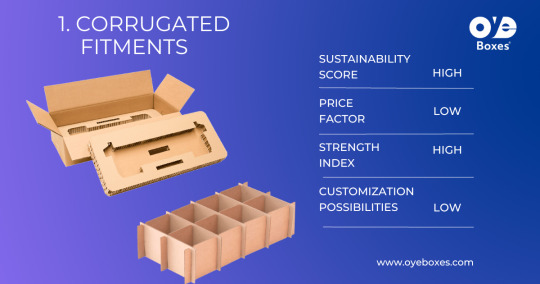
Corrugated Fitments are the most commonly used materials in manufacturing of fitments and inserts. Depending on the use case, either 3 ply or 5 ply fitment sheets are used. Corrugated fitments are made of recycled materials and score high in terms of sustainability. They are usually 30% less expensive as compared to other materials, however you may have to buy them in larger quantities.
Corrugated fitments, inserts, and dividers provide a lot of sturdiness to the contents and can withstand rough transportation as well. They are ideal for products such as glass jars, machine parts, etc.
They have their limitations with respect to colour availability, however they can be offset printed for larger quantities or digitally printed for shorter quantities.
Here’s the rating chart for Corrugated fitments.
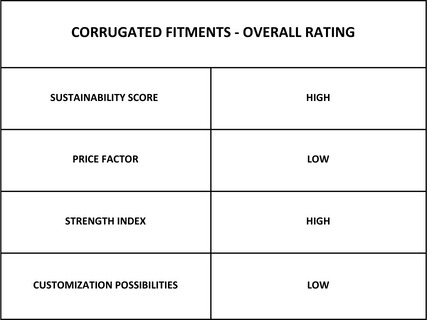
2. Rigid Board Fitments:
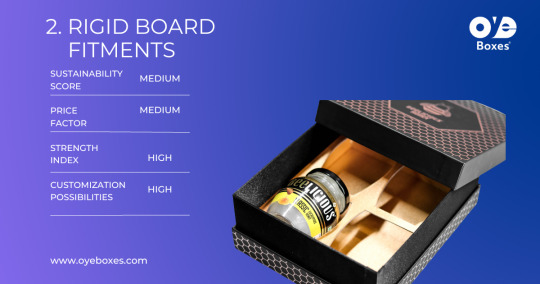
Rigid board fitments are an extremely popular choice when manufacturing fitments for packaging. Rigid fitments are frequently used in packaging for cosmetics, FMCG, jewelry, and other luxury items. Many times they are also used in conjunction with XLPE or EPE foam fitments.
Rigid board, commonly known in India as Putha Board, is made of recycled pulp and scores high in the sustainability index.
The price of rigid board fitments is slightly higher that of corrugated sheets. However, the strength and stability they provide is worth the higher price point. If we choose the appropriate thickness of board for making the fitments, then a very superior level of strength and stability can be achieved in the packaging.
The best part about rigid board fitments is that they are completely customizable. Any type of printed or colour sheets can be pasted on top of these rigid fitments.
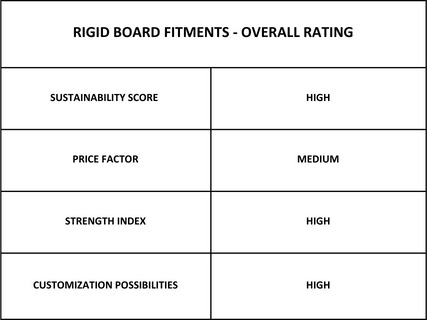
3. Foam Fitments :
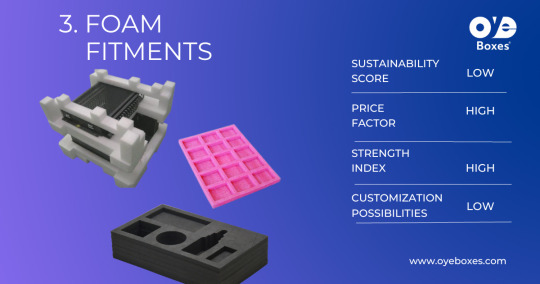
Foam based fitments are widely used in packaging of glass, machine tools, and other high-value items. Currently, two of the most commonly available foam fitments are —- XLPE foam or EPE foam.
As expected, they don’t score well on the sustainability scale. They are harmful to the environment since they are non-biodegradable. But, they are the most sturdy and safe fitment option out there.
And, since they are the most sturdy option available in the market, their price is always on the higher side. We would like to highlight that XLPE foam fitments are 40% more expensive than EPE foam fitments.
Lastly, the customisation of these fitments is very expensive. They generally are available in few colour options – white, black, pink and blue. In order to customise them further, they need a layer of paper or paperboard on top of them.
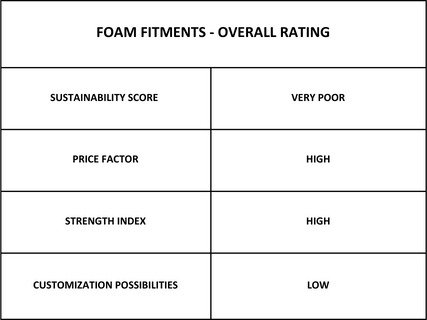
4. Bagasse Fitments

Bagasse is a dry fibrous residue that is generated after extraction of sugar from sugarcane. Nowadays, Bagasse is being used extensively in the making paper moulded fitments and dividers for various packaging applications.
You might be aware of bagasse plates and other recyclable cutlery that are widely used today. Bagasse fitments or inserts are slowly starting to trend in the packaging industry as well.
Bagasse is probably the most eco-friendly material amongst the entire list of fitments mentioned here. It is 100% recyclable. However, the costs associated with making a bagasse mould and then manufacturing these fitments is on the higher end when compared to other paper-based or plastic fitments.
Customization of colours in bagasse fitments is extremely difficult and require extremely large quantities to justify the expense. From a durability standpoint, bagasse fitments are sturdy enough to withstand pressure, however not as strong when compared to foam or rigid board fitments.
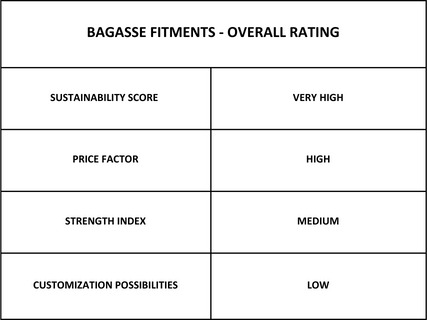
5. Paper Fitments :
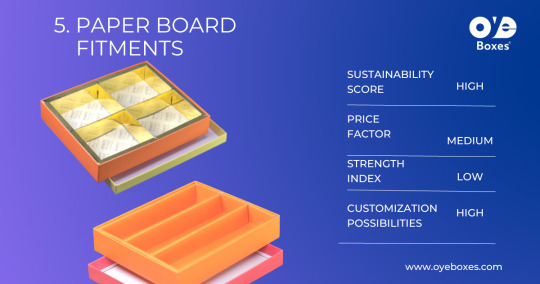
Paper or paperboard fitments are the most pocket friendly fitment option (Probably 25% cheaper than rigid board). These are easy to source and manufacture. Paper fitments are generally made of recycled paper. But, it’s important to remember that they do not provide as much stability as other material options.
The parameter where paper fitments beats the competition is customization. All sorts of customizations are possible with paper fitments, including offset printing, digital printing, foiling, and embossing. So if you are looking for something really unique and tailored to your brand, then paper fitments might be your best bet.

#rigidboxpackaging#rigidboxpackagingfitments#packagingfitments#boxpackaging#CorrugatedFitments#RigidBoardFitments#FoamFitments#BagasseFitments#PaperFitments#luxuryboxpackaging
0 notes
Text
Disposable Tableware

Disposable Tableware is products made from or coated with plastic resin or wood. These are designed for one-time use and are used in dining such as drinkware and dishware.
Dishes made out of plastic feel light on hands which makes carrying them easier than traditional crockery items like plates and cups. This also saves space while serving food because more dishes don’t need to be prepared beforehand compared with glass dinnerware used for this purpose earlier where several glasses have to be set up throughout a party area just before guests arrive so that they may help themselves from these bowls when needed later during an event/function.
The disposable cutleries are not fragile like glass ones, thus making it best suited for all events. More than anything, they are bio-degradable and eco-friendly.
Here are some of the benefits and facts about disposable tableware:
It is produced from recycled paper or bagasse
Bagasse, a sustainable tableware-grade raw material derived from the agricultural residue of sugarcane stalks. It is 100% natural and biodegradable as well as being an abundant resource available in all parts of India!
It can also be manufactured using recycled paper. With multiple layers of sheets, good-quality tableware can be produced as well!
2. They can be laminated or wax-coated to make them sustainable
Laminating or wax coating makes the containers waterproof and it can help them that they can hold food items and drinks efficiently. The material used is toxin-free making it safe for eating.
3. Disposable Tableware is eco-friendly and bio-degradable
Since most of this eco-friendly tableware is made out of bagasse, which is considered sustainable because there aren’t too many harmful chemicals or materials that go into its creation process — this means less pollution will result during production compared to other methods.
These items also don’t pose major problems when disposed of, since they decompose naturally over time without having environmental concerns.
4. Can be manufactured in different shapes and sizes
One of the biggest perks of disposable tableware is that it can be made in a variety of shapes and sizes. Pulp from recycled paper/bagasse gets filled into molds to get products with desired shapes, which happens using some forming machines.
The demand for this disposable tableware has tremendously increased as people in urban and rural areas are tend to use sustainable tableware that saves a lot of time and money. More than anything, it is eco-friendly and bio-degradable.
A majority of paper trading companies in India like The Coniferous are exporting different forms of paper to our neighboring regions to make sustainable and hygienic products.
0 notes
Text
Environmentally Friendly Packaging & the Impact on Customer Satisfaction
In recent years, almost every business has aimed to become as environmentally friendly as possible, whether that be by using environmentally friendly products or just simply turning equipment off when not in use. In the packaging industry, the growing trend of becoming more environmentally friendly has been taken off, and it would seem that even consumers are looking to embrace the trend. Businesses are now starting to choose environmentally friendly packaging over that of non eco-friendly packaging, and consumers are becoming more and more influenced by this choice.
There are a number of ways to make your business more environmentally friendly, with the choice in packaging being the common focus for all businesses. Choosing packaging made from recycled, renewable ingredients is a simple way to reduce negative environmental impact. For packaging to be considered eco-friendly, it must have a minimal impact on the environment during its life cycle (from the creation of the packaging to the recycling of the packaging). There are a number of advantages to using eco-friendly packaging:
Decreases your Carbon Footprint: The obvious benefit to eco-friendly packaging is reducing your carbon footprint. Being made from bio-degradable, recycled materials means there is less waste of natural resources.
Disposal: Another benefit of eco-friendly packaging is the ease of disposal, often costing a considerable amount to move and dispose of supplies. Eco-friendly packaging on the other hand is compostable, reusable, and recyclable, meaning that after its original use, the packaging can be buried (compostable), recycled (Broken down and made into more packaging) or re-used (you can either re-use it yourself or recycle it to be used again).
Brand Image: One of the biggest benefits of using eco-friendly packaging is how it reflects on your business. When consumers learn you’re using eco-friendly packaging, it reinforces the idea that your business is a responsible company, willing to look out for the environment. Better brand image leads to better sales and better profits, all because you looked out for the environment.
Cost Benefits: The best news for your business is that eco-friendly packaging is actually cost-effective. With companies reducing the materials used in their packaging, manufacturing the packaging ends up costing less. With fewer materials, packaging weighs less, saving on transportation costs when compared to before.
However, the main question is, do consumers really care about eco-packaging? Well, fortunately, it appears they do. According to an article from sustainablebrands.com, “more than three-quarters of consumers claim that eco-friendly packaging has an influence on the beverage brand they purchase." Consumers are even willing to purchase products that might cost a little more if the packaging is eco-friendly and are sometimes even willing to avoid a specific brand for their lack of eco-friendly packaging. All of this information has lead to a large majority of businesses taking the environment into account as a part of their business strategy, looking to focus on using eco-friendly materials -- with renewable materials becoming a key focus from businesses.
While the stats do look promising, it’s worth noting that “environmental factors were a bigger influence for more developing countries like Brazil, Turkey and India, than in already developed areas like the UK, USA or Japan.” Developing countries saw around 60% of all surveyed saying that they actively look out for environmental information when thinking about purchases, compared to only 25% from the more developed countries. In another article by campaignlive.co.uk, it is said that in an online survey of 1,000 people, conducted by Toluna, “Almost two-fifths of respondents said they would be more likely to buy a product if it had less packaging than a rival’s. More than one-third said they thought some products have too much packaging, and 32% said they like products to have a lot of packaging, only if they are fragile.” It is shown that consumers link the amount of packaging on a product with value, with over-packaged products causing consumers to believe they will have to pay more for it, as well as the obvious impacts on the environment compared to well packaged eco-friendly packaging.
What is PLA packaging?
Firstly, PLA stands for Polylactic Acid. It’s a new type of high molecular polymer material and is commonly known as corn plastic. PLA is made from renewable resources, is biodegradable and has characteristics similar to Polypropylene (PP), Polyethylene (PE) and Polystyrene (PS). There are many uses for PLA and the most recognised include the following:
Bottles
Biodegradable medical devices (screws, pins, rods, plates etc.)
3D printing
Packaging
How is PLA packaging made?
PLA is a polyester made with two possible monomers or building blocks: lactic acid, and lactide. Lactic acid is produced by fermentation under controlled conditions of a carbohydrate source, such as corn starch or sugarcane, making the process sustainable and renewable.
PLA can be produced by the direct condensation of lactic acid. However, this process usually results in a low-density form of PLA (not ideal). In order to produce high-density PLA, the lactic acid must be heated in the presence of an acid catalyst to form cyclic lactide. This is known as ring-opening polymerisation.
How can PLA packaging be disposed?
When it comes to renewable and biodegradable packaging, the PLA packaging play a key part in the sustainability of the given product.
For PLA, there are two main methods of disposing:
1. Compost degradation – Within the first 180 days of a PLA product’s life, it’s 100% biodegradable and can be composted to ensure sustainability. PLA will decompose into digestible polymer fragments in about 7 days at 60°C in a moist environment - a typical composting condition for a large composting operation.
2. Renewable energy recovery (incineration) – Because PLA doesn’t contain any chlorine atoms, so can be safely incinerated under controlled conditions without producing any dioxins (highly toxic chemicals). Although, as biodegradability is the primary motive for PLA and other bioplastics, incineration should be considered after compost degradation as the end-of-life option.
What is PCR Packaging?
PCR means Post-Consumer Recycled material or Post Consumer Resin, and generally refers to plastics such as PET, PP and HDPE which are widely recycled and then reprocessed into a resin that is used to make new packaging. In simple terms, it is packaging that is being given a second life.
Why use PCR in your packaging?
Principally, because it helps the environment. Virgin plastics are generally processed from fossil fuels so reprocessing them has massive benefits to the environment. But that’s not the only reason to use them:
The more people that use PCR resin, the greater the demand will be. This in turn drives more recycling of used plastic packaging, helping the commercial case to recycle and means that less plastic ends up in landfill, rivers or then becomes yet more plastic in the ocean. So by using PCR, you help the “snowball effect” of recycling.
Many countries around the world are bringing in legislation to force the use of PCR and being a step ahead will help you to be compliant with regulations.
Using PCR adds a responsible element to your brand and shows your marketplace that you care.
Many consumers will be prepared to pay more for products packaged in PCR packaging, making your product more valuable and potentially more profitable.
Sugarcane Packaging Vs Paper Packaging
If you’d like to learn more about our sugarcane packaging tableware range, or the differences between the two types of materials and how they’re used, please reach out to us today.
In our latest blog we explore the differences between sugarcane packaging and paper packaging products, so you can make an informed decision based on your business needs and values.
While products made from paper and the sugarcane by-product bagasse, look and feel similar, their main differences lie in the way the materials are grown and produced.
Not only is sugarcane food packaging a much better alternative than plastic, there’s also quite a big difference in volume of raw product required between paper vs sugarcane food packaging.
We’ll start our article by delving into sugarcane or bagasse containers, as that’s what our compostable tableware range is made from.
How do spray bottles pump fluid?
Spray bottles are an extremely useful type of machine and an excellent demonstration of basic plumbing principles. A spray-bottle head is made up of only a few parts. It has a trigger lever, which activates a small pump. This pump is attached to a plastic tube that draws cleaning fluid from the bottom of the reservoir. The pump forces this liquid down a narrow barrel and out a small hole at the gun's muzzle. The hole, or nozzle, serves to focus the flowing liquid so that it forms a concentrated stream.
The only complex element in this design is the fluid pump, and it's about as simple as they come. The main moving element is a piston, housed inside a cylinder. Inside the cylinder, there is a small spring. To operate the pump, you pull the trigger back, pushing the piston into the cylinder. The moving piston compresses the spring, so when you release the trigger, the piston is pushed back out of the cylinder. These two strokes of the piston, into the cylinder and out again, constitute the entire pump cycle.
The downstroke, the piston pushing in, shrinks the area of the cylinder, forcing fluid out of the pump. The upstroke, the spring pushing the piston back out, expands the cylinder area, sucking fluid into the pump. In a spray bottle, you need to suck cleaning fluid in from the reservoir below and force it out through the barrel above. In order to get all of the fluid moving through the barrel, the pump must only force the fluid up -- it cannot force the fluid back into the reservoir. In other words, the fluid must move through the pump in only one direction.
The device that makes this possible is called a one-way valve. A spray bottle has two one-way valves in the pumping system: one between the pump and the reservoir and one between the pump and the nozzle. Typically, the valve between the pump and the reservoir consists of a tiny rubber ball that rests neatly inside a small seal. The sides of the seal are angled so that the ball won't fall through. Depending on the design, either gravity or a small spring holds this ball against the seal so that the water passageway is blocked off when you are not pumping. When the piston moves out (when you release the trigger), the expanding area of the cylinder sucks on the fluid below, pulling the ball up out of the seal. Since the ball is lifted up, fluid is free to flow from the reservoir. But when you squeeze the trigger, the outward force of the moving fluid pushes the ball into the seal, blocking off the passageway to the reservoir. Consequently, the pressurized fluid is pushed only into the barrel.
In a spray mechanism, the one-way valve between the pump and the nozzle is a sort of cup, which fits over the end of the barrel. On the upstroke, the inward pressure from the pump pulls the cup against the barrel, so air can't flow in through the nozzle. On the downstroke, the fluid pushing out lifts the cup off the barrel slightly and flows on through the nozzle. Without this second one-way valve, the pump system wouldn't be able to draw fluid up from the reservoir because there would be no suction (no drop in air pressure). The upstroke wouldn't lower the air pressure in the pump; it would only draw in more air to maintain that pressure.
5 Benefits of Using Tubes Packaging for Cosmetic Containers
In the cosmetics industry, we can see a great increase in demand for different types of cosmetic products, such as hair removal, anti-aging, and sunscreen products. The interesting thing is that both men and women are the buyers of these products. These products are sold in attract containers that protect the integrity of the material inside. Let's read about some of the benefits of tubes as cosmetic containers.
For cosmetic containers, plastic tubes are becoming the ideal choice. The reason is that they are attractive and versatile. That's the reason they can satisfy the needs of this fast-growing industry. Given below are some reasons these products are a great choice. Read on.
Affordable
Today, consumers are quite conscious as far as spending money is concerned. They try their level best to save as much money as possible. If you want to reduce your packaging costs, you can try the squeeze tubes.
Fancy cosmetic containers, such as glass are quite expensive. Therefore, they add to the price of the product. On the other hand, plastic tubes use the best technology available. Therefore, they are the most affordable option you can try. The cost is low but the container quality is great.
Versatile
Unlike plastic or glass, plastic tubes offer more versatility. The thing is that they are designed to carry a lot of a substance, such as a sunscreen or shampoo. Apart from this, the openings are adjustable to accommodate the product viscosity. This allows you to store different types of substances, such as cosmetic foundations, astringent toners, and creams, just to name a few. So, versatility is another primary benefit of using these tube containers.
Eco-friendly
Heavy jars of plastic and glass containers are quite eco-friendly. As a matter of fact, small containers don't waste plastic as they are recyclable. Actually, the makers of these products make use of green processes in order to have a minimal effect on the environment. Therefore, if you are looking for an eco-friendly option, we suggest that you try out these containers.
Transportable
Unlike glass containers, plastic tubes are more portable. The reason is that they cover less space, easier to transport and are less fragile. They are much easier to ship as they are more stable. Plus, they can make sure that the quality of the product is always high. You can carry multiple tubes in your own pocket.
Easy to use
Unlike jars that need to be unscrewed before each use, tubes are much easier and convenient. All you need to do is pop the lid, press the tube and the substance will come out. Therefore, they are much easier to handle than glass containers, which makes them an ideal choice for most users.
Long story short, these are the benefits of tubes as cosmetic containers. If you are a manufacturer of a cosmetic product, we suggest that you consider using cosmetic tubes. They can help you bring the costs down and offer your products at a much lower price. Hope this helps.
0 notes
Link
#Antigua sugarcane bagasse manufacturer#Styrofoam plate replacement#Eco friendly plates online in Antigua#Sugarcane plates making machine#Sugarcane tableware In Caribbean#Sugarcane bagasse tableware in Antigua#Sugarcane bagasse suppliers#Sugarcane Food Containers Caribbean#Biodegradable tableware Antigua#Eco-Friendly Alternatives to Styrofoam#Biodegradable cutlery and plates#Eco friendly disposable plates and cutlery
0 notes